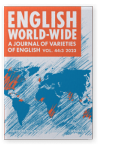Vol. 44:3 (2023) ► pp.403–434
Broadening horizons in the diachronic and sociolinguistic study of Philippine English with the Twitter Corpus of Philippine Englishes (TCOPE)
This paper presents the Twitter Corpus of Philippine Englishes (TCOPE): a dataset of 27 million tweets amounting to 135 million words collected from 29 cities across the Philippines. It provides an overview of the dataset, and then shows how it can be employed to examine Philippine English (PhilE) and its relationship with extralinguistic factors (e.g. ethno-geographic region, time, sex). The focus is on the patterns of variation involving four PhilE features: (1) irregular past tense morpheme -t, (2) double comparatives, (3) subjunctive were, and (4) phrasal verb base from. My analyses corroborate previous work and further demonstrate structured heterogeneity within PhilE, indicating that it is a multifaceted and dynamic variety. TCOPE has shown itself to be useful for exploring both the “general” features of contemporary PhilE and the different forms of variation within it. It contributes to a deeper understanding of Philippine English(es) over time and in different social contexts.
Article outline
- 1.Introduction
- 2.Considerations in corpus compilation
- 3.Procedure
- 4.Composition and distribution
- 4.1Island group
- 4.2City
- 4.3Year
- 5.Format, sub-corpora, and accessibility
- 6.TCOPE in relation to other corpora
- 7.TCOPE in action: Exploratory sociolinguistic analyses
- 7.1Preliminaries
- 7.2Past tense morphology: Use of irregular -t
- 7.3Comparison of adjectives: The use of double comparatives
- 7.4Subordinate counterfactual clauses: Subjunctive were
- 7.5Phrasal verbs: The use of base from
- 8.Conclusion
- Notes
-
Sources -
References
